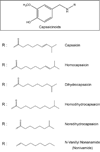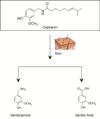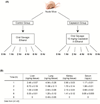Bioavailability of capsaicin and its implications for drug delivery - PubMed (original) (raw)
Review
Bioavailability of capsaicin and its implications for drug delivery
William D Rollyson et al. J Control Release. 2014.
Abstract
The dietary compound capsaicin is responsible for the "hot and spicy" taste of chili peppers and pepper extracts. It is a valuable pharmacological agent with several therapeutic applications in controlling pain and inflammation. Emerging studies show that it displays potent anti-tumor activity in several human cancers. On a more basic research level, capsaicin has been used as a ligand to activate several types of ion-channel receptors. The pharmacological activity of capsaicin-like compounds is dependent on several factors like the dose, the route of administration and most importantly on its concentration at target tissues. The present review describes the current knowledge involving the metabolism and bioavailability of capsaicinoids in rodents and humans. Novel drug delivery strategies used to improve the bioavailability and therapeutic index of capsaicin are discussed in detail. The generation of novel capsaicin-mimetics and improved drug delivery methods will foster the hope of innovative applications of capsaicin in human disease.
Keywords: Bioavailability; Capsaicin; Drug carriers; Metabolites.
Copyright © 2014 Elsevier B.V. All rights reserved.
Conflict of interest statement
The authors declare that they have no conflict of interest.
Figures
Fig. 1
Structure of capsaicin and capsaicinoids.
Fig. 2
A schematic diagram showing the metabolites of capsaicin in rodent and human liver.
Fig. 3
A schematic diagram showing the metabolites of capsaicin in human skin.
Fig. 4
(A) A flow-chart representing the experiment involving the bioavailability of capsaicin in nude mouse (B). A table summarizing the tissue distribution of orally administered capsaicin in nude mouse.
Similar articles
- Infringement of the barriers of cancer via dietary phytoconstituents capsaicin through novel drug delivery system.
Giri TK, Alexander A, Ajazuddin, Barman TK, Maity S. Giri TK, et al. Curr Drug Deliv. 2016;13(1):27-39. doi: 10.2174/1567201812666150603151250. Curr Drug Deliv. 2016. PMID: 26036845 Review. - Anti-cancer activity of sustained release capsaicin formulations.
Merritt JC, Richbart SD, Moles EG, Cox AJ, Brown KC, Miles SL, Finch PT, Hess JA, Tirona MT, Valentovic MA, Dasgupta P. Merritt JC, et al. Pharmacol Ther. 2022 Oct;238:108177. doi: 10.1016/j.pharmthera.2022.108177. Epub 2022 Mar 26. Pharmacol Ther. 2022. PMID: 35351463 Free PMC article. Review. - Capsaicin-the major bioactive ingredient of chili peppers: bio-efficacy and delivery systems.
Lu M, Chen C, Lan Y, Xiao J, Li R, Huang J, Huang Q, Cao Y, Ho CT. Lu M, et al. Food Funct. 2020 Apr 30;11(4):2848-2860. doi: 10.1039/d0fo00351d. Food Funct. 2020. PMID: 32246759 Review. - Nano-sized carriers for capsaicinoids with topic analgesic and anti-inflammatory effects.
Nava-Ochoa AE, Antunes-Ricardo M, Guajardo-Flores D. Nava-Ochoa AE, et al. J Biotechnol. 2021 Jun 10;333:77-85. doi: 10.1016/j.jbiotec.2021.04.009. Epub 2021 May 5. J Biotechnol. 2021. PMID: 33964358 Review.
Cited by
- Design, Formulation, and Evaluation of Aloe vera Gel-Based Capsaicin Transemulgel for Osteoarthritis.
Rompicherla NC, Joshi P, Shetty A, Sudhakar K, Amin HIM, Mishra Y, Mishra V, Albutti A, Alhumeed N. Rompicherla NC, et al. Pharmaceutics. 2022 Aug 29;14(9):1812. doi: 10.3390/pharmaceutics14091812. Pharmaceutics. 2022. PMID: 36145560 Free PMC article. - Does Topical Capsaicin Affect the Central Nervous System in Neuropathic Pain? A Narrative Review.
Alalami K, Goff J, Grimson H, Martin O, McDonald E, Mirza T, Mistry D, Ofodile A, Raja S, Shaker T, Sleibi D, Forget P. Alalami K, et al. Pharmaceuticals (Basel). 2024 Jun 27;17(7):842. doi: 10.3390/ph17070842. Pharmaceuticals (Basel). 2024. PMID: 39065693 Free PMC article. Review. - Pharmacological activity of capsaicin: Mechanisms and controversies (Review).
Zhang W, Zhang Y, Fan J, Feng Z, Song X. Zhang W, et al. Mol Med Rep. 2024 Mar;29(3):38. doi: 10.3892/mmr.2024.13162. Epub 2024 Jan 19. Mol Med Rep. 2024. PMID: 38240083 Free PMC article. Review. - Cellular responses to 8-methyl nonanoic acid, a degradation by-product of dihydrocapsaicin, in 3T3-L1 adipocytes.
Wichai U, Keawsomnuk P, Thongin S, Mukthung C, Boonthip C, Pittayakhajonwut P, Ketsawatsomkron P, Bunyapraphatsara N, Muta K. Wichai U, et al. BMC Complement Med Ther. 2023 Jan 21;23(1):18. doi: 10.1186/s12906-023-03844-w. BMC Complement Med Ther. 2023. PMID: 36681810 Free PMC article. - Potential of Plant-Derived Compounds in Preventing and Reversing Organ Fibrosis and the Underlying Mechanisms.
Azeredo PDS, Fan D, Murphy EA, Carver WE. Azeredo PDS, et al. Cells. 2024 Feb 28;13(5):421. doi: 10.3390/cells13050421. Cells. 2024. PMID: 38474385 Free PMC article. Review.
References
- Govindarajan VS, Sathyanarayana MN. Capsicum--production, technology, chemistry, and quality. Part V. Impact on physiology, pharmacology, nutrition, and metabolism; structure, pungency, pain, and desensitization sequences. Critical reviews in food science and nutrition. 1991;29:435–474. - PubMed
- Caterina MJ, Julius D. The vanilloid receptor: a molecular gateway to the pain pathway. Annual review of neuroscience. 2001;24:487–517. - PubMed
- Bley K, Boorman G, Mohammad B, McKenzie D, Babbar S. A comprehensive review of the carcinogenic and anticarcinogenic potential of capsaicin. Toxicologic pathology. 2012;40:847–873. - PubMed
Publication types
MeSH terms
Substances
Grants and funding
- 1R15CA161491-01A1/CA/NCI NIH HHS/United States
- R15 CA161491/CA/NCI NIH HHS/United States
- P20RR016477/RR/NCRR NIH HHS/United States
- P20 RR016477/RR/NCRR NIH HHS/United States
- P20GM103434/GM/NIGMS NIH HHS/United States
- P20 GM103434/GM/NIGMS NIH HHS/United States
LinkOut - more resources
Full Text Sources
Other Literature Sources



